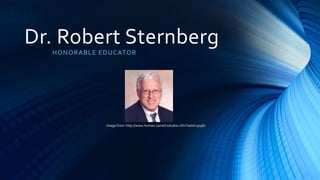
Honorable Educator: Dr. Robert Sternberg
- 1. Dr. Robert Sternberg HONORABLE EDUCATOR Image from: http://www.human.cornell.edu/bio.cfm?netid=rjs487
- 2. Background • Dr. Sternberg earned a B.A. in Psychology fromYale University and a Ph.D. in Psychology from Stanford University • Currently Dr. Sternberg is a professor of human development in the College of Human Ecology at Cornell University • He was previously President and Professor of Psychology and Education at the University ofWyoming. Before that, he was Provost, SeniorVice President, Regents Professor of Psychology and Education, and George Kaiser Family Foundation Chair of Ethical Leadership at Oklahoma State University. He also is Honorary Professor of Psychology at Heidelberg University. He was previously Dean of Arts and Sciences and Professor of Psychology and Education atTufts University, and before that, IBM Professor of Psychology and Education, Professor of Management, and Director of the Center for the Psychology of Abilities, Competencies, and Expertise atYale University.
- 3. Historical Significance • Dr. Sternberg developed theTriarchicTheory of Human Intelligence • TheTriarchicTheory of Human Intelligence is comprised of 3 components: Componential Subtheory, Experiential Subtheory, and Contextual Subtheory • Dr. Sternberg developed theTriarchicTheory of Human Intelligence to broaden the meaning of intelligence beyond conventional psychometric tests • TheTriarchicTheory of Human Intelligence aims to explore one’s own mind as it adapts to the environment
- 4. The Triarchic Theory of Human Intelligence
- 5. Applying the Triarchic Theory of Human Intelligence • Dr. Sternberg conducted research with rural Kenyan children and found their knowledge of herbal medicine to be as important or more important than a conventional test. • Dr. Sternberg and his colleagues captured the practical abilities of U.S. Army officers by describing “tacit” knowledge military leadership so that this information could be integrated into leadership training for cadets. • Dr. Sternberg delivered aTriarchicTheory-based curriculum to multiple grade levels to challenge students’ analytical, practical, and creative abilities.
- 6. Impact of Triarchic Theory of Human Intelligence • Challenged people to expand their interpretation of intelligence beyond using conventional test scores • TheTriarchicTheory of Human Intelligence is widely referenced in psychological and educational literature • There have been criticisms about developing a reliable psychometric instrument to measure practical and creative intelligence. • Diversified view points for educational practitioners regarding teaching to various intelligences including analytical, practical, and creative abilities.
- 7. Notable Accomplishments • Dr. Sternberg developed the Aurora Battery from the research conducted about theTriarchic Theory of Human Intelligence. “The battery is designed for children in elementary and middle schools and captures their analytical, practical, and creative abilities in the domains of dealing with and manipulating words, numbers, and images (i.e., tapping into verbal, mathematical, and spatial representations).The Aurora Battery contains four components, engaging multiple methods and multiple informants. “ • “He was cited in an APA Monitor on Psychology report as one of the top 100 psychologists of the 20th century (#60) and in a report in Archives of Scientific Psychology by Diener and colleagues as one of the top 200 psychologists of the modern era (#61). According to Google Scholar, he has been cited 83,059 times, has an H value of 139, and an i10 value of 689; his most frequently cited publication, according to Google Scholar, has been cited 3622 times. He has been cited by ISI for being one of the most highly cited (top ½ of 1%) among psychologists and psychiatrists.” http://www.robertjsternberg.com/about-main-page/
- 8. Presence in the Field • “Dr. Sternberg is a Past President of the American Psychological Association, the Federation of Associations in Behavioral and Brain Sciences, the Eastern Psychological Association, and the International Association for Cognitive Education and Psychology.” • “He is a member of the National Academy of Education and the American Academy ofArts and Sciences. He is a Fellow of the American Psychological Association, the Association for Psychological Science, the American Educational Research Association, and the AmericanAssociation for the Advancement of Science.” • “He has received roughly two dozen national and international awards, including the Cattell Award fromAPS, and has held about $20 million in research grants and contracts.” http://www.robertjsternberg.com/about-main-page/
- 9. References Beyond IQ. (1985). Retrieved September 08, 2016, from https://books.google.com/books?hl=en&lr=&id=jmM7AAAAIAAJ&oi=fnd&pg =PR11&dq=robert+sternberg&ots=aqyB3duumD&sig=CISYsz3- iM0wK0DDRAavVKEF9aA#v=onepage&q=robert sternberg&f=false Bio. (n.d.). Retrieved September 08, 2016, from http://www.robertjsternberg.com/about-main-page/ Grigorenko, E. (2009, December 23).Triarchic Theory of Intelligence. Retrieved September 08, 2016, from http://www.education.com/reference/article/triarchic-theory-of-intelligence/ Robert Sternberg. (n.d.). Retrieved September 08, 2016, from http://www.human.cornell.edu/bio.cfm?netid=rjs487
